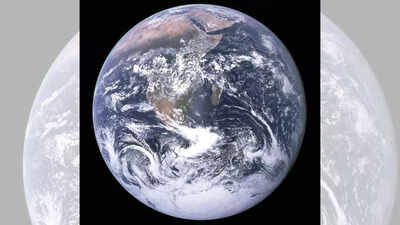ARTICLE AD BOX

Earth
is full of surprising secrets that sometimes seem like they belong in science fiction stories. From strange natural events to hidden places deep underground or in the oceans, many facts about our planet are hard to believe. These mysteries show how incredible and unusual Earth really is. Some of these secrets are so strange they almost sound made up but scientists have discovered they are true. According to a report by Listverse, here are the 10 amazing and hidden
facts about Earth
that feel like they come from a sci-fi movie but are actually real.
10 hidden Earth facts that you might not know
Strange hidden blobs inside Earth from an ancient planet created moon
Earth is incredibly old and about a third as old as the universe itself. Over its long history, it has gone through some huge events including a giant collision with another planet-sized object. About 4.5 billion years ago, a Mars-sized body called Theia crashed into the early Earth. This smash-up created the Moon when the broken pieces of rock came together in orbit. Scientists believe that parts of Theia didn’t become the Moon but stayed inside Earth as two large blobs deep beneath the surface. Today they are known because they change how earthquake waves move through the planet.
Bright auroras covered Earth 41,000 years back
Imagine being an early human 41,000 years ago, just going about your day hunting or gathering food. Maybe you had just caught a giant sloth or picked some berries when suddenly the whole sky started glowing. This wasn’t a story from a sci-fi movie but it really happened because Earth’s magnetic field had weakened a lot. During this time, our planet’s magnetic shield was only about 10 percent as strong as it is now that was causing bright auroras to light up the sky all the way from the poles to the equator. While this made for an amazing light show, it also meant higher radiation from the Sun and space. Those ancient people faced stronger radiation every night and if something like this happened today then it could seriously damage our communication systems.
A new core formed within Earth
Earth actually has two cores which are a liquid outer core and a solid inner core. This setup is really important because the movement of the liquid iron in the outer core creates Earth’s magnetic field which protects us from harmful radiation from the Sun. But this magnetic field wasn’t always strong. About 565 million years ago, it weakened by around 90 percent. Then, in just a short time by geological standards, it regained its strength. Scientists believe this happened because the solid inner core started forming about 550 million years ago that has helped to power up the outer core again. This change may have played a key role in allowing complex life to develop and keeping Earth from becoming like Mars.
How Earth’s molten core influenced early human travel
Earth is like a giant ball with a molten or melted center and this hot interior has influenced life in many surprising ways. Scientists now believe that the swirling molten rock deep inside Earth helped our ancient ancestors move to new places. Around 50 to 60 million years ago, a huge plume of molten rock pushed upward and broke through the crust. This created a land bridge between Africa and Asia about 20 million years ago, passing through areas like the Arabian Peninsula and Turkey. This land bridge allowed many animals including early humans to migrate to new regions. It also helped reshape the oceans by ending one large sea and forming the Mediterranean and Arabian seas. This event ended Africa’s long period of being separated from other continents.
Ancient crystals are 4 billion years old
It’s always interesting when archaeologists find something as old as a 100-year-old can of peas but some discoveries go way further back in time. Zircon is very strong and has survived almost the entire history of our planet. By studying its chemical makeup, scientists learn about Earth’s earliest days including the Hadean eon when Earth was a hot molten ball hit by giant space rocks. But the zircon shows that water existed on Earth as early as 4.3 billion years ago that helped in creating wet environments that may have helped life begin.
There used to be an ocean in Mongolia
One of nature's coolest features is how much it changes over time. Places that are dry land today might have been covered by oceans long ago and the opposite can happen too. A great example is Mongolia. Today it’s mostly dry grassland but about 400 million years ago, it was covered by a vast ocean. This happened when a big molten rock bubble rose up from deep inside the Earth by creating the Mongolian Ocean that lasted for around 115 million years. This was during the Devonian period which is also called the Age of Fishes when many sea creatures started moving onto land. These molten rock movements are part of a cycle that breaks continents apart and opens new oceans like what happened with the Atlantic Ocean.
Is a Supernova blast behind the deep sea anomaly
Scientists found an unusual amount of a rare metal called beryllium deep in the Pacific Ocean. This might be because Earth was hit by material from a nearby exploding star called a supernova. Normally, to date old things, scientists use carbon dating but that only works up to about 50,000 years. For older events, they study how beryllium was created when cosmic rays hit Earth’s atmosphere and break down over time. The extra beryllium could be from a supernova that exploded near Earth around 10 million years ago, sending radiation and star dust our way and leaving this strange mark in the ocean.
A crater that is 3.47 billion years Old
Most craters on Earth don’t last long because weather and erosion wear them away. But the oldest known crater has managed to survive through almost all of Earth’s history. The Pilbara Crater in northwest Australia is about 3.47 billion years old which makes it a billion years older than the previous oldest crater which is also in Australia. When it formed, it was over 60 miles wide. The impact left a raised dome in the crater’s center about 22 miles wide because big impacts create these dome-like features. The collision also sent molten droplets raining down across the planet, among which some possibly reaching as far as South Africa. This event may have been as devastating as the asteroid that wiped out the dinosaurs 65 million years ago.
Oceans were green for millions of years
Our oceans today are a beautiful blue and have inspired many for generations. But a recent study shows that long ago, Earth’s seas were actually green. Researchers in Japan created computer models that looked at things like the chemistry of the seas and atmosphere billions of years ago. Back then, the air had more water vapor and carbon dioxide which caused more iron to wash into the oceans. Because this iron was charged, it made the ocean absorb all colors except green so the seas appeared green. The oceans were also bigger back then which helped in making Earth look like a green marble. This pale green dot lasted from about 3 billion to 600 million years ago. Over time, tiny lifeforms called cyanobacteria produced oxygen which reacted with the iron and turned the oceans blue like they are now.
North America is slowly sinking
North America is slowly sinking, not into water but into the Earth itself. New research from the University of Texas at Austin shows that the bottom part of the continent is actually dripping down through a process called “cratonic thinning.” Cratons are large and very old and stable pieces of rock that make up the core of continents and usually last for billions of years. But sometimes, parts of them start to sink. Scientists think this is happening because an old tectonic plate is sliding deeper beneath the surface. As it sinks, the land beneath the U.S. Midwest is also slowly moving down with it. Thankfully, this is a very slow process and should stop once the plate sinks far enough.Also read: Can science revive dead rhinos? The answer may shock you



.png)
.png)
.png)
















 1 day ago
4
1 day ago
4









 English (US) ·
English (US) ·